Last Updated on March 21, 2024
Need to a new front door? So do we. A front door is functional by keeping homeowners secure and warm, as well as showing off our house’s style and personality.
So when it comes time to replace, shouldn’t we take our time to carefully chose the perfect front door? But wait. How do we do that?
What are the considerations when buying a new front door? (Spoiler Alert – there’s more factors to consider than you think….)
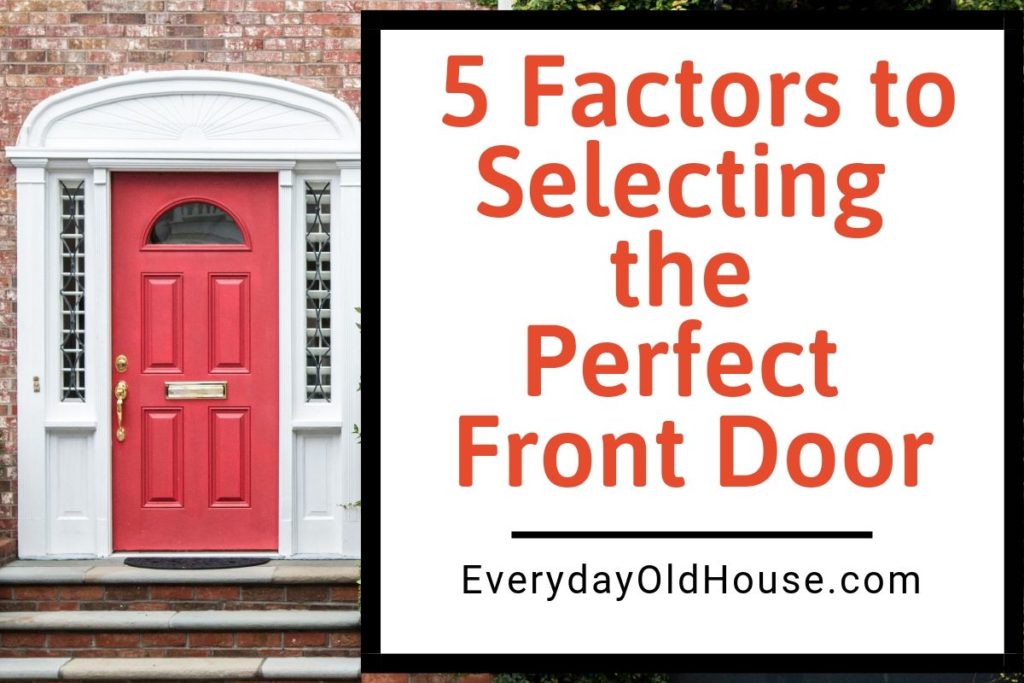
According to Houzz, the entry door is the “part of the façade that makes a statement about who you are”.
Oh my. That seems to be an awfully tall order from a rectangular piece of material. What does my front door currently say? And is that what I want to say to the world?
Currently, my entry door is saying to the world “I’m run down, cracked and I don’t match.”
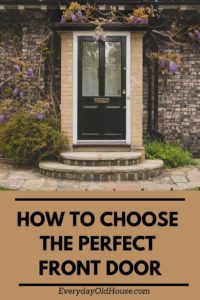
Well, in all honesty, that’s an accurate portrayal of me. I’m a stay-at-home mom of 3 active kids under the age of 6 (including a set of precocious 2-year-old twins) and an overgrown high-energy mutt, all clamoring for my attentions. I wear sweatpants everyday and am lucky if I get to run a comb through my hair.
But that’s not the side of me I want to show the world. Show my friends, yes. But the rest of the world, no.
I’d rather show my, let’s call it my more put-together side. Call it my pre-kids personality. A balance of practicality and attractiveness. Maybe not sweatpants and uncombed hair, but more like classic black pants and a bit of muted lipstick.
Why We Need a New Front Door
A few days after we moved into our house, I was standing in the kitchen looking around at my new space when I noticed something strange about our front door.
Streaks of sunlight sneaking through the front door. Not around the front door. But literally through the front door. About a dozen cracks, about 1-2 inches long in the wood.
Huh, that’s interesting, I thought. What the heck was going on?
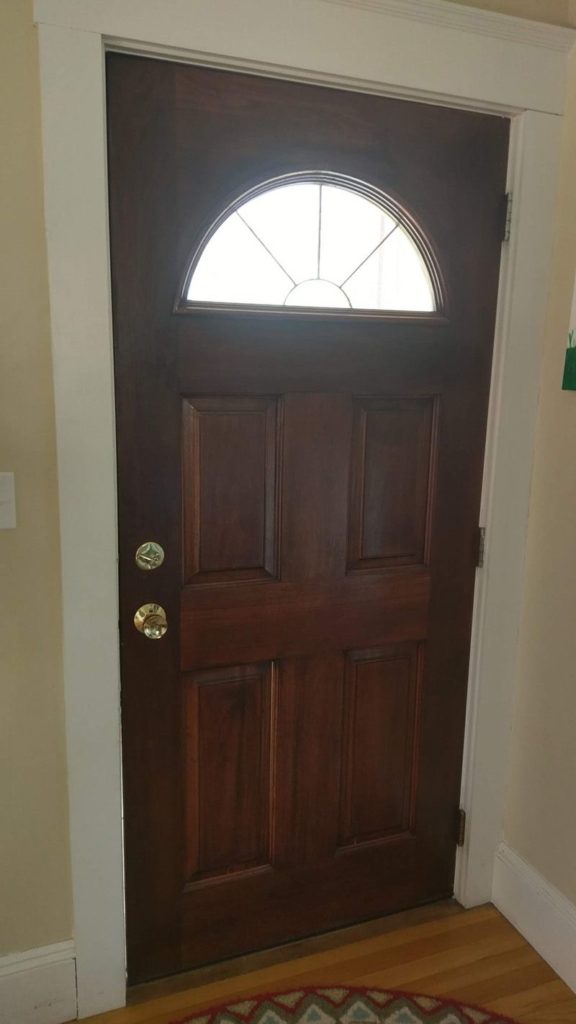
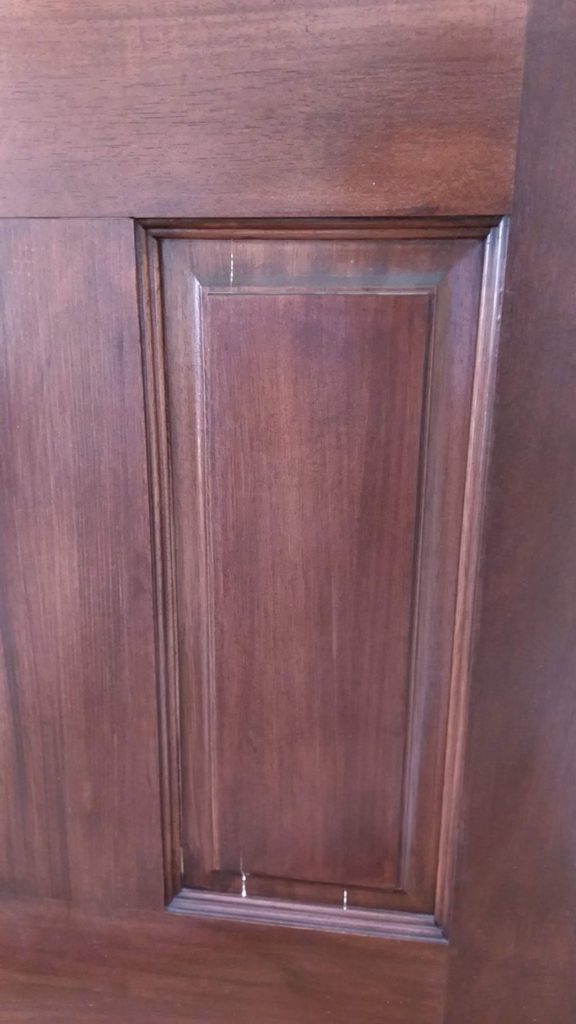
Turns out, our door is made of solid wood. Unfortunately, when solid wooden doors aren’t maintained and exposed to external elements, they split or crack. Whoops! Darn those previous owners!
But being on a budget and having large, expensive projects to tackle (like a new furnace….) replacing the door wasn’t a high priority. So I filled the cracks with wood putty using a toothpick, providing a temporary fix and stop the draft. And “Replace front door” was put on our long to-do list. That never-ending home improvement to-do list that we all have.
And as we know, life has a habit of getting in the way and some projects never get completed. So on the to-do list a new exterior door sat.
Fast forward seven years later….
A few weeks ago on a bright winter day, I was standing in the kitchen and from the corner of my eye I saw it. A streak of sunlight. A couple of streaks, actually. And yes, coming from cracks in the front door. Sigh….
So here I am debating our next move. Actually, I take that back. I know our next move. Last fall, I left my job to stay at home with the kids (twin daughters – SURPRISE!) and reign in the chaos. So with our household income virtually halved, we live a frugal lifestyle until my return.
For now, it’s back to the temporary fix. Applying wood putty and refilling the cracks again using toothpicks. [I must admit that I’m impressed that the original wood putty lasted as long as it did!]
[UPDATE: To help prolong our home’s front door, we recently sanded and painted it a BEAUTIFUL blue color. I have to admit, I was impressed with how it turned out! Hopefully this front door makeover we help us squeeze a few more years of use out of it…]
But I still dream about a new front door. In the meantime while we enjoy the fresh coat of paint, we also plan for how exactly we choose a new one.
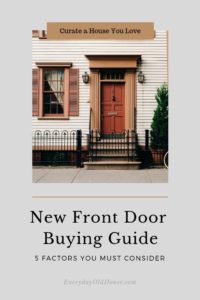
How do we pick a new door? What are the considerations when buying a new front door? I’ve never bought a new entry before. At first glance it sounds easy. Just go to the store and pick one out, right?
Wrong! As with all home improvement projects, nothing is ever simple and easy…Especially with challenges posed by older houses. Sigh…
I’m a bit of a type-A personality that loves to research. Some people (a-hem, my husband) might say I research things “to death”. But I would disagree. ?
After researching and reviewing the experts’ opinions, in general there are 4 considerations when buying a new front door:
- Material
- Style
- Energy efficiency
- Security
But I’d like to include a 5th one…. Budget. I’m a homeowner. And I think we homeowners would all agree that budget is an essential factor in each and every home improvement project.
1. Material
Today’s front doors are usually constructed out of 3 different materials (or a combination of these materials): wood, fiberglass and steel. And as with all building materials, there are pros and cons to each.
To be honest, there are a variety of inconsistencies in pros and cons of each material on websites. For example, one website promoted fiberglass as almost indestructible, while another was all-in on steel doors. If you disagree with my list below, I’d love to hear from you!
Wood
Pros:
- Provides authentic wood grain and heavy door feel
- If an older house, this material is true to the original
- Installation easier in older houses since it can be planed to fit quirky angles
Cons:
- Durability
- Naturally warps and rots with exposure to moisture and outdoor elements
- Doesn’t stand up as well to small nicks and dents (or pet scratches)
- Lower energy efficiency, but can be made with a energy-efficient core
- Maintenance required, including resealing and touch up stain or paint due to fading from sun and natural elements
- Limited warranties. Commonly, manufacturers don’t warranty their products for sun damage and require a certain length of roof overhang
Fiberglass
Pros:
- Durable – while still susceptible, it is less likely to crack, scratch, fade, dent or rust
- Moisture-resistant
- Doesn’t rust, scratch, or dent as easily
- Resists sun and weather damage
- Versatile – can be designed to feature a wood grain texture
- Low maintenance
- High energy-efficiency
- Broad warranty
Cons:
- Custom orders for doors that are not standard size are rare, which could be a challenge for older homes
- During installation, impossible to trim door to fit an old house’s quirky frame.
Steel
Pros:
- Least expensive
- Security – provides the best protection against burglars or thieves
- Low maintenance
- High energy-efficiency
- Broad warranty
Cons:
- Shorter lifespan than wood or fiber
- Durability – tends to be more durable than wood, but less durable than fiberglass
- If dented, hard to repair
- Vulnerable to rust
- Conducts temperature, so not good for extreme hot or cold environments
- Custom orders for doors that are not standard size are rare, which could be a challenge for older homes
- During installation, impossible to trim door to fit an old house’s quirky frame.

My future door? I love old houses, so I assumed that I would automatically pick wood. It’s what the original door to our 1916 house would have been. I’m not a true preservationist but any stretch of the imagination. But when it makes sense, we are restoring our old house back to its original condition.
But I have to admit that fiberglass provides a compelling argument. For me, a steel door is definitely out. It just doesn’t have enough pros to warrant consideration. So when the time comes, we will focus on wood and fiberglass doors.
2. Style
The front entry door should be a reflection of your home’s architectural style as well as play up your personality. Hmm…. But how do you figure out that that reflection may be? How do you maximize curb appeal with style and personality?
Architectural style
First, figure out the style of your house. Traditional? Modern? Colonial? Victorian? Craftsman? Farmhouse?
Something about our front door has never sat right with me. There is something about it that just doesn’t fit the house. And I finally figured it out. It’s the wrong architectural style.
Recently I started researching the history of my house. Part of tracing the house’s history is identifying its architectural style. Using a handy-dandy guide, I identified my house as an American Foursquare home.

This type of house was built during the Arts & Crafts (“Craftsman”) era (1880s-1920s). This style was characterized by simple, straight lines that focused on craftsmanship.
Craftsman entry doors usually have decorative glass on top (usually divided into a series of small squares) with an ornamental shelf called a “dentil” underneath. Now that I know which style of door my house should have, I’ve been collecting ideas on my Pinterest board for inspiration.
As a side note, remember to consider if adding glass in your door makes sense. For us we do want glass near the top of the door from a style standpoint. But also makes sense that it allows light to enter the house, and provides security so that we can look out and see who is standing at the front door.
If you need help in identifying your home’s architecture, check out Beth’s How to Match the Right Window and Door Styles to Your Home.
Personality
In addition to matching the house, the entry door needs to also match your personality. The best way to reflect personality and add curb appeal to your front door? Color.
Do you want to natural wood stain color? Or as all the interior design folks say “a pop of color”? To help decide, check out these resources:
- Stain door
- Doityourself.com provides tips on what to consider when choosing the right stain for your door.
- Painted door
- If you are into quizzes, Pella (a national window and door manufacturer) has a short color personality quiz to learn more about the entry door hue that’s right for you.
- Homecraft, Inc., also a window and door company but focused in the Mid-Atlantic has a color guide to give a glimpse into personalities.
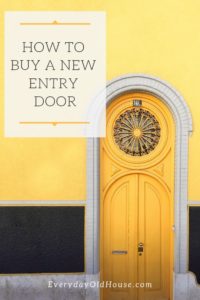
My future entry door? I’m unsure. Part of me likes natural wood stain. But painting the front door is an opportunity to do something playful with our somewhat plain house. A few years ago we painted the entire house in earthy, muted colors consistent with the Craftsman period. So perhaps we could apply a third color to the house’s palate. A color still consistent with the period, but helps our door “pop” a bit out of its alcove.
(If you have any suggestions, I’d love to hear them in the Comment section below!)
3. Energy Efficiency
As an average homeowner, I have no expertise in the energy efficiency of doors. It’s not like you can just look at door and know if it’s energy efficient. (Although in my case with light coming through noticeable cracks in the door, it’s safe to say we have energy-efficiency issues….). While we can’t see it, this is one of the most important of the considerations when buying a new front door.
In general, there are 3 ways to evaluate energy efficiency of a new front door.
ENERGY STAR

Make sure any door you choose is ENERGY STAR certified. ENERGY STAR is the symbol you see on so many products. It’s a federal government-backed program that provides simple, credible, and unbiased information that consumers and businesses rely on to make well-informed decisions on energy efficiency.
National Fenestration Rating Council
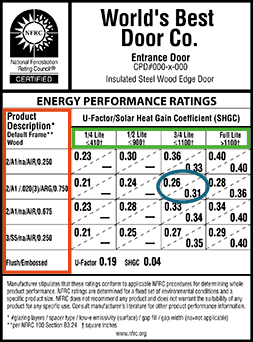
While the ENERGY STAR certification applies across a broad range of household products, the National Fenestration Rating Council (NFRC) certification is specific to windows, doors and skylights. (Fenestation refers to all things related to windows, doors, and skylights).
The NFRC label dives in a bit deeper and helps you compare between energy-efficient windows, doors, and skylights by providing you with energy performance ratings in multiple categories.
R-value
The R-Value provides a measure of thermal resistance. It’s a traditional measure of a variety of insulation products. The higher the R-value of the energy efficient entry door, the better the insulation. For example, a R-10 rating is higher than a R-3.
4. Security
Attractiveness and energy efficiency are important, but we all need a secure door. Safety and peace of mind that you are keeping intruders out of your home is essential.
For the most part, the security of your door is not related to the actual door, but the right hardware, especially locks. There are a variety of locks available, with deadbolt and keyless pad entries being the most common on entry doors. Too many options to get into here. But with regards to the door itself, consider these two factors:
- Ensure that your entry door is solid. Not hollow. Doors with hollow cores are easy to kick in or break. If you’re unsure if a door is solid or hollow, knock on it. Solid doors sound “dead,” while hollow doors echo.
- Design your entryway so that you have a method to see who at the front door. Whether it be glass, or a peephole, or security camera.
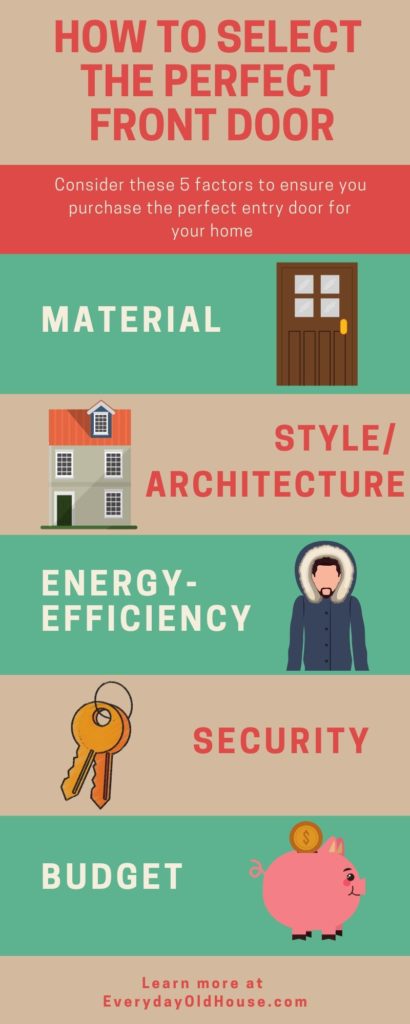
5. Budget
I’m frugal. Ok, certain family members may say cheap. But once we have some extra funds I’m completely on board with buying a new door. Why? Two reasons.
- Compared to other home improvement projects, doors are not that expensive
- Entry doors have a high Return on Investment (ROI)
New Exterior Door Cost
First, new doors are not that expensive compared to other home improvement projects. According to HomeAdvisor.com, materials make up the majority of the overall cost. Below is the range of the standard cost of each type of door material calculated by Home Advisor, with a range when adding upgrades such as glass an sidelights.
Wood
An exterior solid wood entry door ranges from $500 to $3,000 depending on wood type, whether a single or double door, or includes upgrades such as glass and sidelights.
Fiberglass
Fiberglass doors cost anywhere from $150 to $5,000 but most fall in the $250 to $2,000 range.
Steel
The cost of a standard steel types ranges between $150 and $300, or with glass or sidelights upgrades averaging range of $1,000 to $1,500.
Installation
In addition to the material cost, the average installation cost nationwide according to Home Advisor is around $950, with the typical range of $473-1,422. Installation cost depends on the scope and complexity of the project.
Entry Door Return on Investment (ROI)
New entry doors consistently top the list for the home improvement projects with the highest Return on Investment (ROI).
What does ROI mean to homeowners?
When we sell our house, we will recoup the majority of the money we spent to buy and install our new front door.
Remodeling Magazine‘s 2019 Cost vs. Value Report calculates that homeowners will get back 70-75% of the cost for a new steel or fiberglass door. (I couldn’t find the percentage for new wood doors). That percentage makes is one of the best remodeling projects to offer a decent financial return.
Stay Tuned!
Whew! I hope these 5 considerations when buying a new front door help you pick the perfect door! After doing all this research, I’m so glad I’m planning ahead.
I’ll post an update when we go through the buying process – so stay tuned! I’m excited to put the experts’ considerations for buying a new front door to the test and see if they work for us. Or if there are other factors that we found more important during the process of buying our door.
In the meantime, have you recently purchased a new front door? What was your experience? Did you consider other factors when buying your new front door? Please comment below – I’d love to hear your thoughts and experiences.

If still working through the considerations when buying a new front door, take a listen to this episode of the Fix-It Home Improvement podcast about entry doors. The first half is about how to chose a new front door, while the second half is how to install. At least to the first few minutes to hear why Einstein painted his front door red….
Tips/Other Considerations
I wanted to add a few more tips and suggestions I came across in my reading. Admittedly, it’s partly selfish since I need a place for my notes to refer to when we are ready for our new entry door!
- A handy-dandy Glossary of Door Terms for Beginners once we get into the nitty-gritty of buying a door
- YesterYear’s Vintage Doors in upstate NY maintains a website with a ton of pictures of vintage wood doors for inspiration and ideas.
- If we decide on wood, we will consider wood certified by the Forest Stewardship Council (FSC) or Sustainable Forestry Initiative. This ensures that the wood used in manufacturing our door was sustainable grown and harvested.
- Old door removal: What about your old door? Will your installation contractor salvage it? If not try to keep it out of a landfill. Post on social media outlets, like Facebook Marketplace or Craig’s list to see if you can unload for someone’s use. Or if interested in keeping the door, check out Paulina’s blog 19 Creative DIY Project Ideas of How to Reuse Old Doors.
- If dedicated to true preservation of your old house, check out salvage yards for a new door. Or visit Old House Journal’s list of Architectural Salvage Products and Services Directory. You might enjoy Alex and Wendy’s adventures in their quest to find salvaged doors. While using a salvaged door is tempting, I’m not comfortable not knowing its energy-efficiency rating.
Want to be the first to know about new posts? Be sure to follow me on Pinterest, Facebook, Instagram or Twitter of even Etsy! Or better yet… Subscribe below!
My monthly (admittedly sometimes more, sometimes less….) emails are like receiving a unexpected letter from an old friend WITHOUT needing to put on your slippers and walk out to your mailbox…. See? I got ya, my friend!)
[Note: My posts are proudly connected to these amazing link parties full of DIY ideas and inspiration!]
Photo credits: Landon Martin, Christian Koch, Peter Bocchia, Sabrina Mazzeo, and Karla Caloca all on Unsplash.com
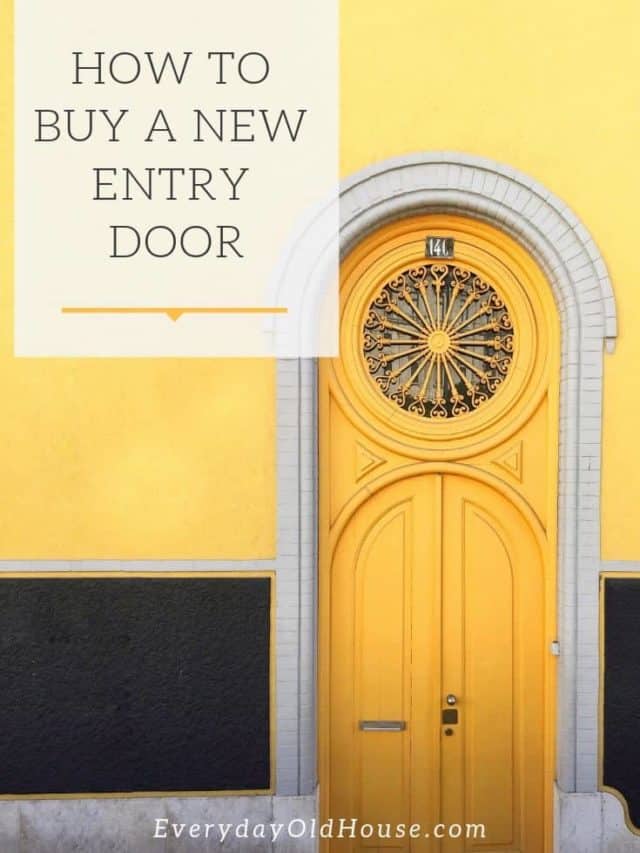
I had no idea that front doors are usually made out of wood, fiberglass, and steel, as you said in the article. My father is renovating his house so that he can raise its value and sell it for a profit. He has been talking about wanting to replace his front door, so it may be good for him to find a company that offers a wide variety of doors for him to choose from.
Hi Dean – Thanks for reaching out. From what I can tell from digging into various websites that we homeowners are lucky to have many different materials to chose from when we buy a new entry door. And each type of material – steel, fiberglass, or wood – have unique strengths and features that appeal to different audiences. Good luck to your dad with selling his house!